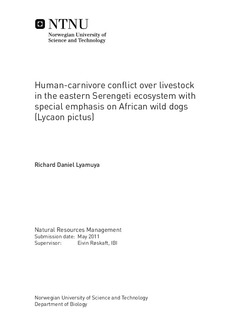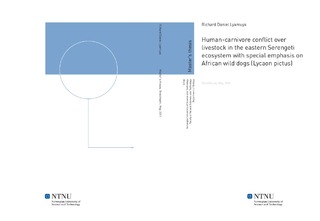| dc.description.abstract | AbstractHuman-carnivore conflict is currently one of the main constraints to biodiversity conservation efforts outside many protected areas worldwide. A survey of livestock depredation caused by wild dogs (Lycaon pictus) and other wild carnivore species in the Maasai and Sonjo areas outside Serengeti National Park, Tanzania over two periods between 2007/09 and 2010 using different methodologies indicated a high level of conflict. The conflict related to African wild dogs proved the most significant conflict during both periods compared with that related to other carnivores. Wild dogs were found to cause more attacks in the Maasai area (n = 229, n = 18) than in the Sonjo area (n = 111, n = 9) over both observation periods. However, the difference in attack rates was attributed to a difference in the size of the livestock populations, as there were approximately 318,209 animals belonging to the Maasai tribe, while the Sonjo tribe had only 78,191 livestock. Therefore, wild dogs were found to exert a statistically significantly higher depredation rate (1.42 animals per 1000 per year) related to the Sonjo tribe compared with the Maasai tribe (0.72 animals per 1000 per year), as estimated only during the first period. African wild dogs were found to be the most common predator in both areas for both periods. However, in the second period, leopards (Panthera pardus) and spotted hyaenas (Crocuta crocuta) were also found to be quite common predators in both areas. Shoats (sheep & goats) were depredated more frequently than cattle/donkeys by wild dogs and other carnivores in the area. Livestock depredation was found to occur most frequently during evening. While shoats were found to be most frequently attacked during the wet season, cattle/donkeys were most frequently attacked during the dry season. The results of this study recommend that traditional livestock husbandry techniques should be improved, as should the use of non-lethal control measures. Prevention and control measures for diseases that can affect both livestock and wildlife should be instituted in the area to enhance the survival rate of young animals. If possible, herders should bring their livestock back to boma before 16:00 hrs in the evening. Shoats should be more attentively looked after during the wet season. Furthermore, eco-tourism activities should be encouraged in the area. To achieve these aims, the reinforcement of wild dogs conservation awareness programmes in the area is a possible way forward. | nb_NO |

